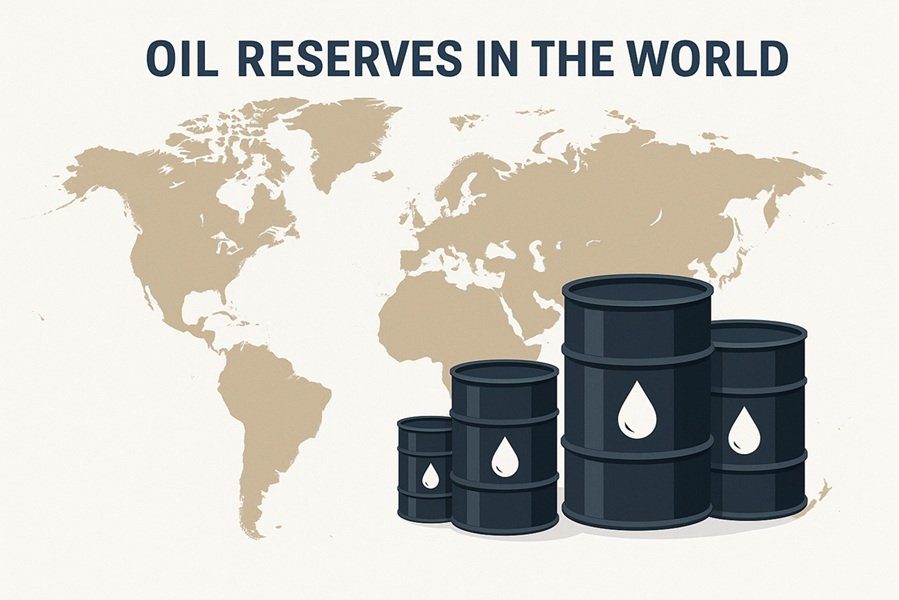
Introduction
Oil has shaped the modern world more than any other natural resource. From transportation and power generation to plastics, chemicals, and fertilizers, crude oil has fueled industrial development and global trade for over a century. To understand how long this dominance may continue, it is important to study global oil reserves — where they are concentrated, how they are extracted, and what influences their future value.
Oil reserves refer to the estimated quantities of crude oil that can be extracted using current technology and under present economic conditions. These reserves are not fixed; they change as new discoveries are made, technologies advance, or oil prices fluctuate.
Types of Oil Reserves
Oil reserves are classified into three major categories based on certainty and recoverability:
1. Proven Reserves
These are oil deposits that are confirmed by geological and engineering data and can be extracted commercially with high certainty. Proven reserves are often used as the standard measure when comparing countries.
2. Probable Reserves
These reserves are believed to be recoverable but with less certainty than proven reserves. Their commercial extraction depends on improvements in technology or long-term price changes.
3. Possible Reserves
These are speculative resources that might be extracted in the future, depending on major technological breakthroughs or favorable economic shifts.
Global Distribution of Oil Reserves
Oil reserves are not evenly distributed around the world. Some regions are naturally richer in oil-bearing sedimentary basins, while others have little extractable crude.
Middle East
The Middle East remains the global powerhouse of petroleum, holding a significant share of the world’s most accessible reserves. Countries like Saudi Arabia, Iran, Iraq, Kuwait, and the United Arab Emirates possess vast underground fields of high-quality crude oil.
South America
Venezuela holds the world’s largest proven oil reserves. However, much of its oil is extra-heavy, requiring expensive extraction and refining methods. Political and economic instability also affects its production levels.
North America
Canada has enormous oil sands reserves, particularly in Alberta. The United States has large shale oil deposits, unlocked in recent decades through horizontal drilling and hydraulic fracturing.
Eurasia and Russia
Russia is one of the largest oil producers and has extensive reserves in Siberia and the Arctic regions.
Top Countries by Proven Oil Reserves (Approximate)
| Rank | Country | Estimated Reserves (Billion Barrels) | Notes |
|---|---|---|---|
| 1 | Venezuela | ~300+ | Largest reserves, mainly heavy oil. |
| 2 | Saudi Arabia | ~260+ | High-quality, easily extractable crude. |
| 3 | Iran | ~200+ | Large reserves but limited by global sanctions. |
| 4 | Canada | ~160+ | Mostly oil sands requiring advanced extraction. |
| 5 | Iraq | ~140+ | Widely untapped due to decades of conflict. |
| 6 | Russia | ~80+ | Large Arctic and Siberian reserves. |
These six nations alone hold the majority of global proven reserves, giving them tremendous influence in shaping international oil markets.
Economic and Geopolitical Importance of Oil Reserves
Oil reserves are not just geological assets—they are strategic instruments of national power.
1. Economic Revenue
Countries with large oil reserves often rely heavily on oil exports to finance government spending, development, and infrastructure.
2. Global Trade Influence
Nations with surplus production capacity can influence global oil prices. For example, Saudi Arabia often adjusts its production to stabilize markets.
3. Energy Security
Countries lacking domestic reserves, such as India, Japan, and many European nations, depend on imports. This makes them vulnerable to price fluctuations and geopolitical tensions.
Challenges in Oil Extraction
Even when reserves are abundant, several challenges affect extraction:
- Technical Difficulty: Deep-water, Arctic, and oil sands require sophisticated technology.
- Cost Factors: Low oil prices can render complex extraction uneconomical.
- Environmental Concerns: Oil extraction contributes to carbon emissions and can damage ecosystems.
- Political Instability: Conflicts and sanctions can reduce actual production, regardless of reserves.
The Future of Global Oil Reserves
The world is undergoing a transition toward cleaner energy sources. However, oil is likely to remain important for several decades due to its role in:
- Heavy transportation (ships, aviation)
- Petrochemical manufacturing (plastics, pharmaceuticals)
- Industrial processes (steel, cement)
As renewable energy expands and electric vehicles become mainstream, oil demand growth may slow, but not disappear immediately.
However, one crucial shift is expected:
High-cost and high-emission reserves may remain unused if cleaner energy becomes cheaper and more widely adopted.
India’s Perspective
India has relatively small domestic reserves, mostly located in Assam, Gujarat, Rajasthan, and offshore regions. Because of its large population and growing industrial activity, India is one of the world’s largest importers of crude oil. Therefore:
- Securing diversified supply sources,
- Strengthening strategic petroleum reserves, and
- Encouraging renewable energy,
are essential components of India’s long-term energy strategy.
Read this: What is the Nuclear Non-Proliferation Treaty (NPT)?
Conclusion
Global oil reserves continue to play a central role in shaping the world’s economy, diplomacy, and energy systems. While the world gradually moves toward renewables, oil will remain critical in the near future, especially for transportation and industry. Understanding where reserves lie, how they are used, and how they might change over time is vital for governments, investors, and policymakers alike.



